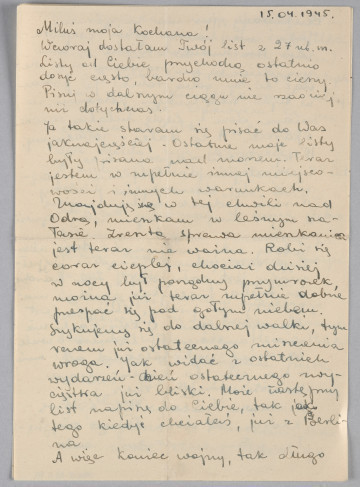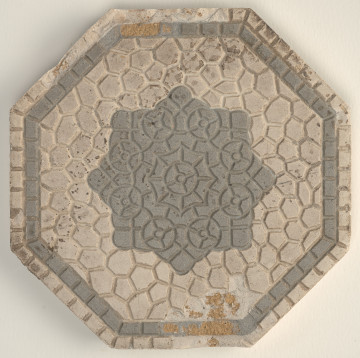
A letter
1945
Museum of the history of Polish Jews
Part of the collection: Floor tiles
The gift from Krystyna Erbel, one of the first to be donated to the POLIN Museum collection after the appeal for sharing memorabilia. It is the hexagonal ceramic, unglazed tile. On the face there is a two-colour pattern (in beige and grey-blue colours). There is a grey-blue six-pointed star in the centre. A grey-blue band runs along the edge. The whole surface of the plate is covered with a spatial, uneven pattern imitating cracks. The manufacturer's mark in the form of a six-pointed star can be seen on the back in the central part.
Krystyna received the tiles from her friend Nina Krajewska shortly before her death, stating that they had been found during the cleaning of the former synagogue site in Praga. They were probably found by students who lived with Nina's neighbour in a student hostel and who left the tiles in their room when they moved out. For Krystyna, the tiles were special for two reasons. Firstly, as they came from a particular synagogue - she understood their historical value. The Prague synagogue had existed since the late 18th century, and its building, where prayers were held until World War II, was built in 1836; damaged during the war, it was finally demolished in the mid-1950s or in 1961 (for more on the Prague synagogue, see https://sztetl.org.pl/pl/miejscowosci/w/18-warszawa/112-synagogi-domy-modlitwy-i-inne/89749-wielka-synagoga-gminna-na-pradze-w-warszawie).
Secondly, Krystyna kept the tiles, remembering the little girl she had contact with when she lived during the war right next to the wall of the Warsaw Ghetto, at the corner of Pańska and Żelazna Streets. Krystyna's family received a flat in a tenement house (at 71 Pańska Street?) excluded from the so-called Small Ghetto after 10 August 1942, when, after the great liquidation action, the borders of the ghetto were significantly reduced and a fragment of the residual ghetto was created in this part of the city with the Duży Többens shed. The new wall ran along Pańska and Żelazna Streets. Twelve or thirteen-year-old Krystyna could see through her window the interior of the flat of the tenement house remaining on the side of the residual ghetto; it happened that a girl, Krystyna's peer, appeared in the window of his balcony.
From an interview with Krystyna Erbel (Róg Pańskiej i Żelaznej (The Corner of Pańska and Żelazna Streets)), Midrasz 2017, no. 2): My tenement house had under my window, under the windowsill, an approximately half-metre-high cornice with sheet metal and a gutter. This cornice obscured me - it was the third or fourth floor, high up, so it would be all the more difficult to see me from a street bisected by a wall. [...]She had a balcony from Pańska Street. She didn't open the balcony, she just stood by the door, pushed against the wall and turned sideways towards me. We were communicating by signalling. What can you tell each other by signalling? But just eye contact... I was petite, small - because there was nothing to eat, war children were quite thin - I would lie down on the windowsill. I showed her dolls, some toys, books. [...] I don't know what she saw from there, I couldn't lean out too much. I was also very careful not to let anything fall out of my hands, I could only take certain objects. She was also showing me something. [...] And so it went on. I can't even say if it was long or short. Until I witnessed how they liquidated that part of the ghetto and threw everyone out of their flats and shot them at that wall. I didn't see the shooting, because I couldn't lean out that far, I only heard it. I went through a terrible experience and to this day I can't recall it. No one appeared behind the glass anymore, and then they set the fire.
PK
Author / creator
Dimensions
cały obiekt: height: 17 cm, width: 17 cm
Technique
burning
Material
ceramics
Creation time / dating
Creation / finding place
Owner
POLIN Museum of the History of Polish Jews
Identification number
Location / status

1945
Museum of the history of Polish Jews

post 1883
Museum of the history of Polish Jews

1930 — 1939
Museum of the history of Polish Jews
DISCOVER this TOPIC
Museum of King Jan III's Palace at Wilanów
DISCOVER this PATH
Educational path